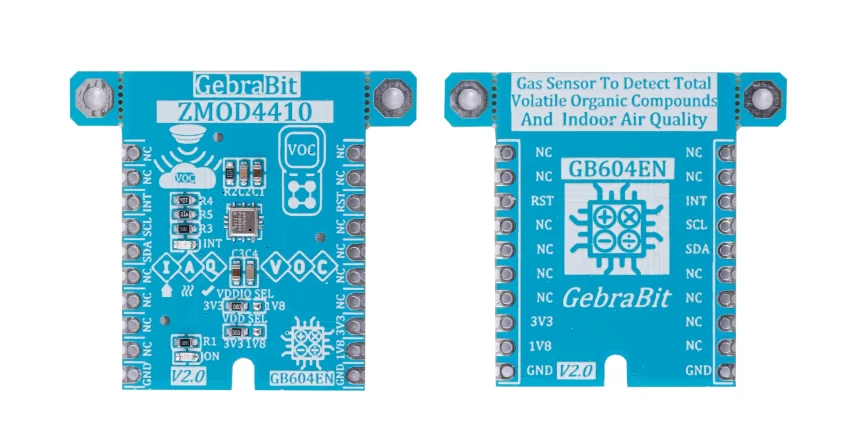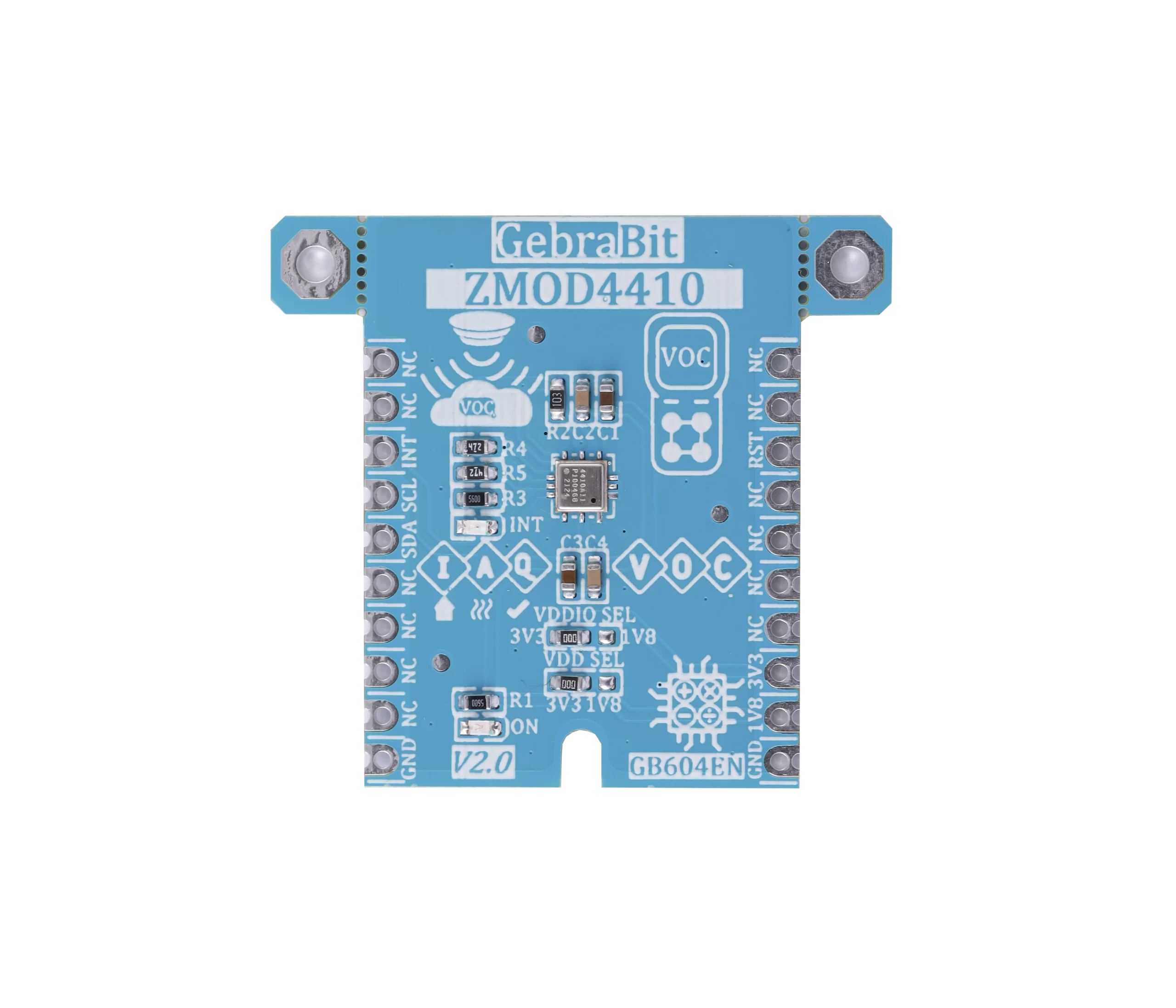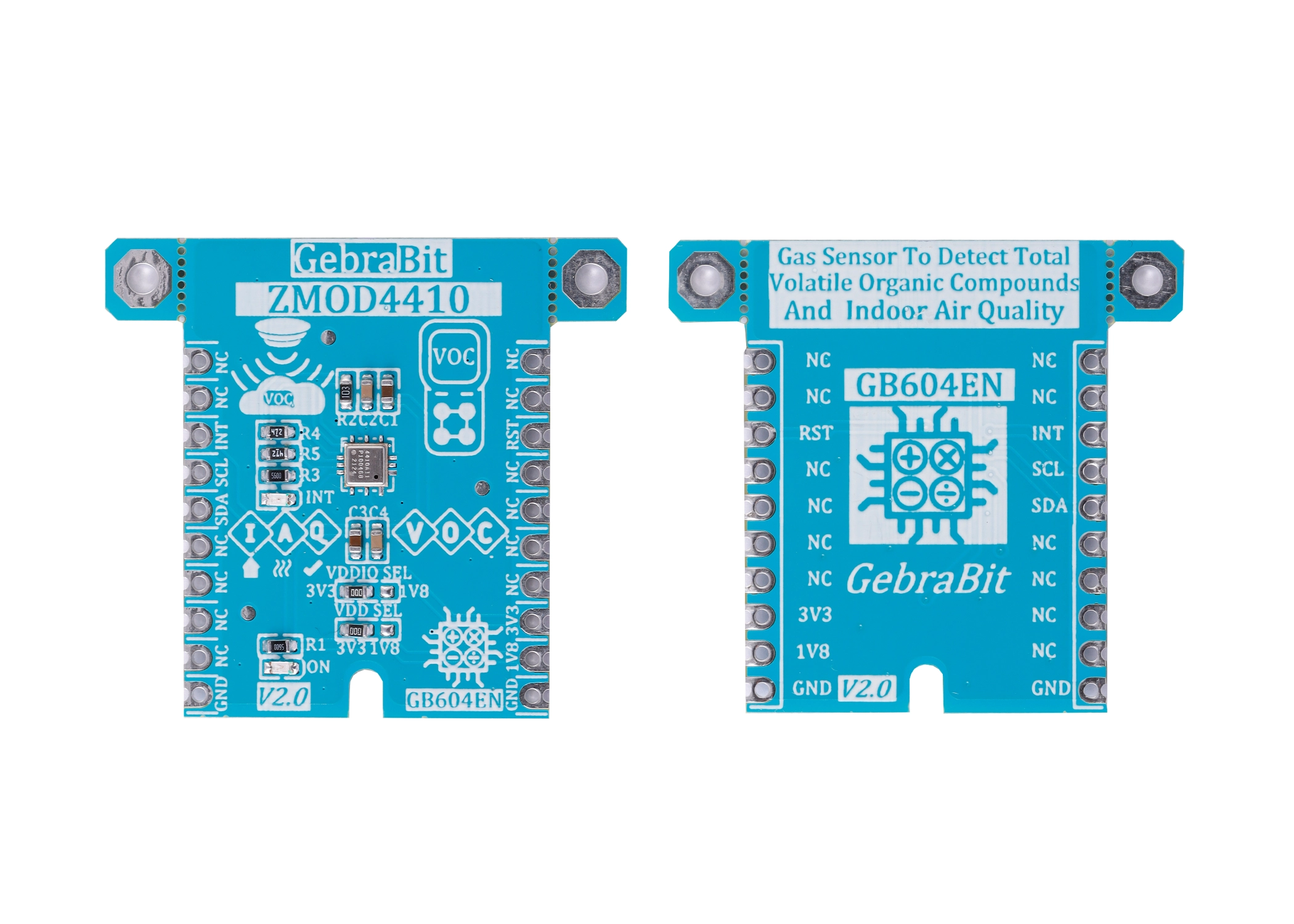Air quality sensors are devices used to detect particles, pollutants, and harmful gases in the air that may be harmful to human health. They are used in air quality monitoring, gas detection in industry, combustion controllers, oxygen generators in plane, etc…
Volatile organic compounds or VOCs are created when harmful chemicals evaporate at ambient temperature. Large manufacturing factories that use toxic solvents or chemicals during production can release dangerous levels of VOCs into the air. These gases create photochemical smog, which can cause severe problems for human health and harm the environment.
VOC sensors are made to detect any changes in certain gases and send the data to a central monitoring system. The factory personnel use these sensors to prevent any unexpected increase in the emission of these types of gases. Depending on the type of sensor used, technicians can calibrate each device to detect a specific VOC or a group of them.
An overview of the ZMOD4410 sensor

The ZMOD4410 Gas Sensor Module is designed for easy implementation to detect total volatile organic compounds (TVOC), estimate CO2, and monitor indoor air quality (IAQ). The module works reliably in various conditions, including very humid and dusty applications with the possibility of water spray, condensation, or immersion. The small LGA assembly consists of a gas sense element and a CMOS signal conditioning IC. The sense element is a Si-based microhotplate with a robust and highly sensitive metal oxide (MOx) chemiresistor. The signal conditioner (ASIC) controls the sensor temperatures and measures the MOx conductivity, which is a function of the gas concentration. The measurement results are easily read via an I2C interface with the user’s microprocessor, which processes the data.
Specification
Application
- Detection Range: 0 to 1000 ppm
- Resolution Ratio: 10 to 16 Bit
For more specifications, please refer to datasheet
- Indoor air monitoring to meet UBA and WELL standard
- Monitor home, office, environments for healthy conditions and comfort
- Detect hazardous materials and unhealthy conditions
- Automation based on indoor ambient air quality
ZMOD4410 module Key Features
- User-selectable module power supply voltage between 3V3 and 5V
- On Board, ON/OFF LED indicator
- GebraBit Pin Compatible with GEBRABUS
- It can be used as a daughter board of GebraBit MCU Modules
- Featuring Castellated pad (Assembled as SMD Part)
- Separatable screw parts to reduce the size of the board
- Package: GebraBit small (36.29mm x 32.72mm)
GebraBit ZMOD4410 module

GebraBit ZMOD4410 module can operate with “1V8” or “3V3” supply Voltages by Considered “VDD SEL” jumper selector. Also there is another jumper named “VDIO SEL “, which is regarded to select logic level voltage of module I/O pins between “1V8” or “3V3”. This feature helps to use a wide range of microcontrollers for interfacing with this module. User can interface with GebraBit ZMOD4410 by I2C protocol with the module.
Due to the LGA package and since it’s difficult to access to sensor pins, the user needs a starter circuit and driver for the hardware development and of course the software development of the ZMOD4410 sensor. For the convenience of users, this work has been done by implementing the ZMOD4410 sensor circuit and providing access to the sensor important pins.

It is enough to put the GebraBit ZMOD4410 module in the BreadBoard, then by applying the proper voltage set up the GebraBit ZMOD4410 module with any of Arduino, Raspberry Pi, Discovery board, and especially we recommend using GebraBit microcontroller development modules (GebraBit STM32F303 or GebraBit ATMEGA32 module) then receiving the data.

The reason for our recommendation when setting up the GebraBit ZMOD4410 module with GebraBit microcontroller development modules (such as GebraBit STM32F303 or GebraBit ATMEGA32), is the presence of an internal 3V3 regulator on these modules and the compatibility of the pin order of all GebraBit modules together (GEBRABUS standard), it’s enough to Put the ZMOD4410 in the corresponding socket as shown in the above picture and develop the desired sensor module without the need for wiring.
Introduction of module sections

ZMOD4410 sensor
ZMOD4410 is the main IC of the following module which is responsible for monitoring the air quality. It is located in the center of the module and its circuit is designed.

VDDIO SEL jumper
According to the state of 0R resistance of this jumper, the logic level of the sensor digital communication (I2C) can be selected between 1V8 and 3V3.

VDD SEL jumper
According to the state of 0R resistance of this jumper, the main voltage of sensor power supply is selected between 1V8 and 3V3.

Interrupt LED
A dedicated LED is considered for the interrupt pin on the module and its status changes when the interrupt state changes according to the sensor data sheet.

Power supply LED
According to the state of the VDD SEL jumper and applying voltage to the module by the corresponding pin, the LED of the module will be lit.

GebraBit ZMOD4410 Module pins

Supply pins
- 3V3 and 1V8: These pins can supply the sensor main power supply and the logic level of the sensor digital connection (I2C) according to the state of the VDDSEL and VDDIO selector jumpers.
- GND: This is the common ground pin for power and logic level of the sensor.

I2C pins
- SDA: This pin is the I2C communication data pin, which is connected to the corresponding data pin in the microcontroller (processor). According to the state of the VDD SEL jumper, you can use the logic level with a voltage of 1V8 or 3V3.This pin is pulled up with a resistor.
- SCL: This pin is the I2C communication clock pin, which is connected to the corresponding clock pin in the microcontroller (processor). Depending on the state of the VDD SEL jumper, you can use the logic level with a voltage of 1V8 or 3V3. This pin is pulled up with a resistor.

Other pins
- INT: It’s the Interrupt pin of ZMOD4410 sensor, When a measurement is running, this pin is set to “High” and when the measurement is finished, it is set to “Low” state. According to the datasheet, the user can set the interrupt conditions, the modes and methods of the interruption, etc.
- RST: This pin is the reset pin of the sensor and is an active low pin.

Connect to the processor

I2C connection with GebraBit STM32F303
For I2C connection of GebraBit ZMOD4410 and GebraBit STM32F303 microcontroller module, after defining SDA and SCL on pins PB9 and PB8 (for convenience in STMCUBEMX), follow the below steps:
- Connect the 3V3 pin of the ZMOD4410 module to the 3V3 output pin of the microcontroller module. (Red wire)
- Connect the GND pin of the ZMOD4410 module to the GND pin of the microcontroller module (Black wire).
- Connect the SCL pin of the ZMOD4410 module to the PB8 pin of the microcontroller (SCL) module (Blue wire).
- Connect the SDA pin of the ZMOD4410 module to the PB9 pin of the microcontroller (SDA) module. (Yellow wire)
You can see how to connect the above mentioned steps in this picture:

Note: Considering that the PA14 pin of the GebraBit STM32F303 microcontroller module is used to program the microcontroller, I2C setting on the PA14 and PA15 pins is impossible in this version, so in this version for I2C connection with the GebraBit STM32F303 microcontroller module, GebraBit ZMOD4410 module cannot be placed on it as Pin to Pin. To make a more convenient connection between the two modules, you can select the SPI protocol by using the on-board jumpers and then place the GebraBit ZMOD4410 module as Pin to Pin on the GebraBit STM32F303 module.
I2C connection with GebraBit ATMEGA32A
Considering that the I2C pins of the ATMEGA32A microcontroller are based on the GEBRABUS standard and correspond to the I2C pins of other GEBRABIT modules, the GebraBit ZMOD4410 module can be placed pin to pin on the GebraBit ATMEGA32A module and communicate with the GebraBit ZMOD4410 module via I2C. Here, for better understanding, the separate connection of these two modules is shown:

Note: If you are using GebraBit microcontroller modules, note that the jumper selectors of the GebraBit ZMOD4410 are set to 3V3 so that you can easily power-on the GebraBit ZMOD4410 module by getting the 3V3 voltage from the microcontroller module.
I2C Connection with ARDUINO UNO
Follow the below steps to connect the GebraBit ZMOD4410 module to the ARDUINO UNO via I2C:
- Connect the 3V3 pin of the ZMOD4410 module to the 3V3 output pin of the ARDUINO UNO board. (Red wire)
- Connect the GND pin of the ZMOD4410 module to the GND pin of the ARDUINO UNO board (Black wire).
- Connect the SCL pin of the ZMOD4410 module to the A5 pin of the ARDUINO UNO board (SCL). (Blue wire)
- Connect the SDA pin of the ZMOD4410 module to the A4 pin of the ARDUINO UNO board (SDA). (Orange wire)
You can see how to connect the above mentioned steps in this picture:




